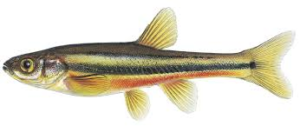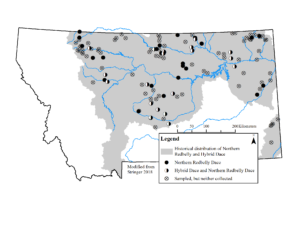Northern Redbelly Dace
Status of Northern Redbelly Dace (Chrosomus eos) in Montana

© Joseph Tomelleri
Allison L. Stringer
U.S. Forest Service
Bozeman, MT
allison.stringer@usda.gov
Niall G. Clancy
Montana Fish, Wildlife & Parks
Kalispell, MT
niall.clancy@mt.gov
March 2020
DESCRIPTION
The Northern Redbelly Dace (Chrosomus eos, syn. Phoxinus eos) is a small-bodied minnow (family Leuciscidae, syn. Cyprinidae) native to the United States and Canada. Individuals have very small scales, an incomplete lateral line, 7–8 dorsal fin rays, and a moderately forked caudal fin (Brown 1971). Northern Redbelly Dace have a small, s-shaped mouth that does not reach below the front of the eye. Coloration is olive/brown on top with two dark stripes running laterally down its sides, from snout to tail. The lower sides and bellies are typically yellow or silver but, during spawning season, turn bright red on adult males. Brown (1971) reported that no individual larger than 2.3 inches had been reported in Montana; however, multiple surveys have since reported Northern Redbelly Dace approximately 4 inches long (FishMT 2020).
Northern Redbelly Dace often co-occur with Northern Redbelly X Finescale Dace hybrids (Chrosomus eos × C. neogaeus), but most biologists cannot reliably distinguish between the two in the field. In the lab, one may definitively identify them using pharyngeal tooth counts, intestinal complexity, genetic testing, or a combination of the three (New 1962). Northern Redbelly Dace occur more widely and in higher numbers than their hybrids, and most hybrid dace are probably misidentified as Northern Redbelly Dace in the field. This uncertainty in identification has caused some confusion about their statuses and co-occurrence in the past (Stringer 2018).
LIFE HISTORY, BEHAVIOR, AND ECOLOGY
The life history, behavior, and ecology of Northern Redbelly Dace has not been studied in Montana, but they have been observed elsewhere. Northern Redbelly Dace typically spawn from May to August, usually in a mass of filamentous algae. Females lay batches of up to 30 eggs, each batch fertilized by a different male. Eggs hatch in 8–10 days at water temperatures between 21° and 27° C (Brown 1971). Bestgen (1989) found that most individuals in Colorado prairie streams typically only survive to age-2, but longer-lived populations have been reported in Quebec (Legendre 1969).
Schooling behavior has been observed in lake populations of Northern Redbelly Dace with large congregations in shallow areas during the day and more dispersed, individualistic behavior at night (Naud and Magnan 1988). They primarily consumed detrital plant material and small invertebrates in Colorado (Bestgen 1989), but few studies have examined Northern Redbelly Dace diets elsewhere. We also know relatively little about their role as a forage fish, but they almost never co-occur with large-bodied piscivorous fish (Bestgen 1989; Chapleau et al. 1997; Whittier et al. 1997; Findlay et al. 2000; Trumpickas et al. 2011; Aiken et al. 2012). Moreover, little overlap occurs between Northern Redbelly Dace and populations of non-native trout and Northern Pike (Esox lucius) in Montana, and they are probably highly vulnerable to these invasive predators (Stringer 2018).
DISTRIBUTION AND HABITAT
The range of Northern Redbelly Dace includes much of southern Canada and the northern United States, from eastern British Columbia to Nova Scotia and from Montana to Maine (Lee et al. 1980). Relict populations of Northern Redbelly Dace also occur in Colorado, South Dakota, and Nebraska (Lee et al. 1980). Although Northern Redbelly Dace are widely distributed, they appear to be rare in the prairie portion of their range (Bestgen 1989; Stasiak 2006; Felts and Bertrand 2014).
Montana contains the southwestern periphery of the continental range of Northern Redbelly Dace. In Montana, Northern Redbelly Dace historically occurred in the Missouri, Little Missouri, lower Yellowstone, and Saskatchewan River basins (Figure 1). However, they appear to have been extirpated from the Little Missouri drainage in Montana sometime between 1993 and 2016 (Stringer 2018). Disjunct populations occur in the lower Gallatin and Madison River basins; however, we know little about their abundance or wider distribution in these drainages because no targeted surveys have been conducted.
Northern Redbelly Dace live in clear, coolwater streams and ponds with slow flowing water and abundant aquatic vegetation, especially filamentous algae (Holton and Johnson 1996). The majority of collections in Montana have occurred at locations with mean August stream temperatures between 13° and 18° C (Clancy, unpublished data). Bestgen (1989) reported that Northern Redbelly Dace only occurred in waterbodies where microhabitats <22° C were available. In the Milk River of north-central Montana, Northern Redbelly Dace were found exclusively in tailwaters below dams (Stash 2001).
CONSERVATION STATUS AND MANAGEMENT
The Northern Redbelly Dace is currently listed as an “S3” species of concern in Montana because they are potentially at risk because of limited and/or declining numbers, range and/or habitat, even though it may be abundant in some areas (MTNHP 2020). Northern Redbelly Dace have declined across their range and are at moderate risk of extirpation in Montana (Stringer 2018). Individuals were collected from only 42 of 73 streams (58%) with historical observations in a 2015–2017 study of Northern Redbelly Dace distribution, which corresponds with an estimated range contraction of 32–67% (Figure 1; Stringer 2018). This contraction most likely resulted from the invasion of Northern Pike and non-native trout throughout their range. Of 36 fish-bearing streams surveyed in 2012 on the Fort Peck Reservation, Northern Pike were absent from 17 sites, and only 5 of these “non-pike” sites contained populations of Northern Redbelly Dace (Hendricks et al. 2013). Habitat degradation has probably also played a role in their range reduction and has been shown to negatively affect Northern Redbelly Dace elsewhere (Whittier et al. 1997).
Exclusion or removal of non-native predators affords the best chance of conserving Northern Redbelly Dace (Stringer 2018). In the Musselshell River, a series of diversion dams probably restrict upstream movement of both native and non-native fishes. Although passage at some diversions is needed to reconnect native Sauger (Sander canadensis) with historical spawning areas, retention of the Stella and Parrot diversion dams will probably prevent the spread of Northern Pike and other invasive species into the upper Musselshell (M. Ruggles, Montana Fish, Wildlife & Parks, personal communication). Ongoing work will prioritize dam removal and retention in areas likely to serve as climate refugia for dace and other native fishes (Clancy, unpublished data). Furthermore, managers should carefully consider the consequences of stocking Northern Pike or trout into drainages containing Northern Redbelly Dace. Establishing a prairie fish monitoring program would allow managers to gain a better understanding of long-term population trends of Northern Redbelly Dace (and other native prairie fishes) and the potential need for a conservation-hatchery option.
REFERENCES
- Aiken, J. K., C. S. Findlay, and F. Chapleau. 2012. Long-term assessment of the effect of introduced predatory fish on minnow diversity in a regional protected area. Canadian Journal of Fisheries and Aquatic Sciences 69:1798–1805.
- Bestgen, K. 1989. Distribution and notes on the biology of Phoxinus eos (Cyprinidae) in Colorado. The Southwestern Naturalist 34:225–231.
- Brown, C. J. D. 1971. Fishes of Montana. Big Sky Books, Bozeman, Montana.
- Chapleau, F., C. S. Findlay, and E. Szenasy. 1997. Impact of piscivorous fish introductions on fish species richness of small lakes in Gatineau Park, Québec. Ecoscience 4:259–268.
- Felts, E. A., and K. N. Bertrand. 2014. Conservation status of five headwater stream specialists in South Dakota. The American Midland Naturalist 172:131–159.
- Findlay, C. S., D. G. Bert, and L. Zheng. 2000. Effect of introduced piscivores on native minnow communities in Adirondack lakes. Canadian Journal of Fisheries and Aquatic Sciences 57:570–580.
- FishMT. 2020. Fisheries Information System. Montana Fish, Wildlife & Parks, Helena, Montana. Available: www.fwp.mt.gov/fish
- Hendricks, P., S. Lenard, D. Stagliano, and B. A. Maxell. 2013. Baseline nongame wildlife surveys on the Fort Peck Indian Reservation. Report to the Assiniboine and Sioux Tribes of the Fort Peck Indian Reservation. Montana Natural Heritage Program, Helena, MT. 83 pages.
- Holton, G. D., and H. E. Johnson. 1996. A Field Guide to Montana Fishes. 2nd Edition. Montana Fish, Wildlife & Parks, Helena, Montana.
- Lee, D., C. Gilbert, C. Hocutt, R. Jenkins, D. McAllister, and J. Stauffer, Jr. 1980. Atlas of North American freshwater fishes. North Carolina Museum of Natural History, Raleigh.
- Legendre, P. 1969. Two natural hybrids of the cyprinid fish Chrosomus eos. McGill University, Montreal, QC.
- MTNHP. 2020. Montana Field Guide. Montana Natural Heritage Program, Helena, Montana. Available: http://fieldguide.mt.gov/speciesDetail.aspx?elcode=AFCJB31020
- Naud, M., and P. Magnan. 1988. Diel onshore-offshore migrations in northern redbelly dace, Phoxinus eos (Cope), in relation to prey distribution in a small oligotrophic lake. Canadian Journal of Zoology 66:1249-1253.
- Stash, S. W. 2001. Distribution, relative abundance, and habitat associations of Milk River fishes related to irrigation diversion dams. Master’s thesis. Montana State University, Bozeman, Montana.
- Stasiak, R. H. 2006. Northern Redbelly dace (Phoxinus eos): a technical conservation assessment. Report to the U.S. Forest Service, Rocky Mountain Region, Species Conservation Project, Golden, Colorado.
- Stringer, A. L. 2018. Status of Northern Pearl Dace and chrosomid dace in prairie streams of Montana. Master’s thesis. Montana State University, Bozeman.
- Trumpickas, J., N. E. Mandrak, and A. Ricciardi. 2011. Nearshore fish assemblages associated with introduced predatory fishes in lakes. Aquatic Conservation: Marine and Freshwater Ecosystems 21:338–347.
- Whittier, T. R., D. B. Halliwell, and S. G. Paulsen. 1997. Cyprinid distributions in Northeast U.S.A. lakes: evidence of regional-scale minnow biodiversity losses. Canadian Journal of Fisheries and Aquatic Sciences 54:1593–1607.

Figure 1. Collections of Northern Redbelly Dace and hybrid dace from their historical distribution in a 2015–2017 study of their current status and distributions in Montana (adapted from Stringer 2018).

